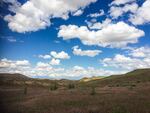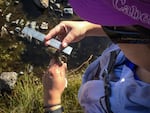Producer: Vince Patton Videographer: Nick Fisher Editor: Bruce Barrow Aerials: Idaho Public Television
Out on the desert, many animals do just fine. Sage grouse thrive in the brush. Snakes wriggle in the sun and hide under rocks. Pronghorn range for miles, as do mule deer, badgers and birds.
We were intrigued to hear there’s an animal that must stay in the water, yet cannot travel far, out in the land of parched streambeds.
Marisa Meyer encouraged us to meet her team out in the middle of miles of sagebrush.

Owyhee desert country does not appear at first glance to be prime frog habitat.
Vince Patton / Oregon Public Broadcasting
“We’re about two, two and a half hours south of Vale, Oregon,” Meyer says.
Meyer is a biologist for the US Fish & Wildlife Service. She promises we will see frogs in the middle of the desert.
“This little oasis, this Dry Creek really isn’t dry,” says Meyer. “It’s kind of comical it’s named Dry Creek.”
About half a dozen researches from US Fish & Wildlife and the Bureau of Land Management wear waders and walk slowly up the creek. When one spots a frog, others slow down or circle around with nets extended.
“Good catch!” becomes the most common expression of the day.
They are catching Columbia Spotted Frogs. It’s part of a
, which has checked for frogs along this same creek three times a year ever since 2001.
Meyer says, “Our goal is to catch every frog we see. It’s kind of a lofty goal.”
Every frog gets a checkup for weight and length and then gets added to the population count.

Each frog captured gets measured, tagged and released back to the creek.
Vince Patton / Oregon Public Broadcasting
USFWS Biologist John Stephenson says, “This is one of those rare spots you can go hundreds of miles before you find strips of water like this. But this is one of them. It’s a very valuable place.”
Stephenson marvels at how these frogs have managed to survive in isolated pockets across southeastern Oregon.
“The desert is really a pretty rich habitat,” he says. “We have these spring fed streams and certain oases in the middle of the desert. They’re extremely valuable.”
Without water, the frogs would have no place to live. Fortunately, Dry Creek seems to have perpetual springs that never stop – even in the driest months.
“They’re very tied to the water,” says Meyer. “They do not stray from the water.”
If water does retreat in the heat of summer, the frogs must trek over land to nearby water. They’re not able to travel far.
Meyer says, “Hopefully it happens in a time when they can travel overland short distances. And I’m talking maybe 10-15 feet.”

Springs feed Dry Creek even in dry summer months. Researchers have conducted surveys for frogs here for more than a decade.
Vince Patton / Oregon Public Broadcasting
The researchers don’t want to accidentally count the same frog twice.
So they scan their “barcodes.”
Each frog ends up with electronic tag the size of a grain of rice implanted in its back.
Meyer says, “A PIT tag is a Personal Identification Transponder tag. Each tag has a unique number.”
If the scanner beeps, the frog has a tag. They let it go and don’t count it again. Silence means it’s time to slide a PIT tag under the loose skin of its back.
“We’re able to track individual frogs through the years,” says Meyer. “It doesn’t have a battery that dies. So years from now if the frog has a tag in it, you can go ahead and find information out from that frog.”
Columbia spotted frogs live in small, scattered populations all around the great basin.
They didn’t just hop here.
Researchers believe they’ve been here for eons.
“They’re old,” says Meyer, “tens of thousands of years. Back in the day this area didn’t used to be so arid. So they’re kind of holdovers from the Ice Age. We believe they were a lot more widespread and the frogs in Dry Creek are kind of left over.”

Columbia spotted frog.
Vince Patton / Oregon Public Broadcasting
In the western part of the state, Oregon spotted frogs are a species of concern.
In eastern Oregon, Columbia spotted frogs also have worrisome numbers, with just 200 to 300 frogs detected in the last couple of years.
Meyer says, “Dry Creek is the
we know of so this is kind of spotted frog central.”
So what did it take for a hearty amphibian to last tens of thousands of years – even as its landscape grew drier and drier?
It might not have been any special adaptation in their bodies.
Says Stephenson, “I think it’s the consistent water source is the biggest thing. Otherwise frogs wouldn’t be here.”
They just have a knack for finding the green oasis in a sea of brown.
